Inertia of mind is sometimes mind boggling. I’ve started my serious photography life with Sony nex-5 camera which replaced a briefly owned Nikon D40 for the reason of compactness, but then I’ve found out there are no e-mount lenses! Particularly, I were missing a compact 35mm equivalent lens which would not cost 1000 eur (there was native sonnar 24 1.8 at the time, but not much else). So, the quest for the legacy glass which eventually led me to full-frame and the Leica world begun.
There’s no lack of e-mount lenses anymore, and I moved to full-frame (A7) since, but I still use legacy glass almost exclusively, and still try to find a decent 24-28 compact option. Now not because it is 35 mm equivalent on crop, but rather because I started to love that focal length as the smartphones changed the world and became the camera you always have with you. It looks, however, that my quest is over now.
It would be several years earlier, when I’ve got my FE 28mm f/2, but since I started to shoot film with my Leica M4-P, this old friend somehow could not fully satisfy me anymore, so I started to look for a lens which would work both on my Sony A7 and Leica. As you might know, the A7 series has a “thick filter stack” which makes this task almost impossible, but it turns out there are at least couple of options!
First, I’ve acquired a Snapshot Skopar 25mm, which is an extraordinary lens on film, and can perform decently on A7 (more on that next time), but the problem is there are no matching frame lines on M4-P (or any Leica), so one has either to use external viewfinder or guesstimate framing. Moreover, at f4 it’s a tad slow, so environmental portraiture is out of question when it gets dark. Mind you, I still have and use it, but there had to be something more. This more turned out to be the hero of todays post – the m-rokkor 28mm 2.8. The lens which became my main lens both on A7 and M4-P for the time being.
I discovered this option on the internet, when searching for wide m-glass performing well on A7. It turns out the options are not many (filter stack!), and most people have only heard of Ultron 21mm f/1.8 (too wide and big), and Leica Tri-Elmars (too rare and expensive). Then, I’ve found some posts that showed that the Minolta M-Rokkor 28mm f/2.8 also appeared to be not too shabby: no colour cast even on the A7R (the worst of the bunch in this respect), and reasonable sharpness too!
All at 137 grams without caps (measured by me). That’s actually the main reason (behind the fact that I like MF) I shoot Leica glasswork on digital. As illustrated in picture below, which shows my current travel set:
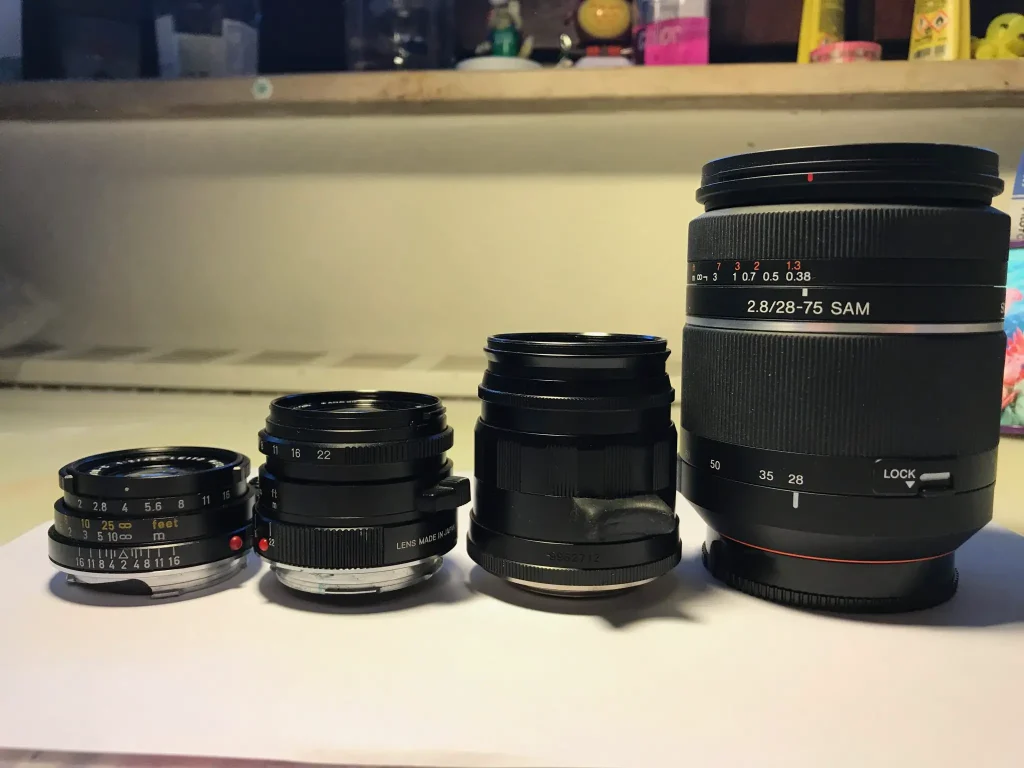
The Minolta M-Rokkor 28mm f/2.8 is second from the left, and is one of the smallest M lenses around. In practice I have one of the three on the left on my camera and the other two in two pockets, which is really convenient. The nice thing about Rokkor is that M4-P also has frame lines for that, so I started to search for one on a well-known auction site. But there was a problem. First, the lens was produced for Minolta CLE, which was not the most-popular m-camera ever, so the lenses are also quite rare.
More importantly, however, is that there seems to be a major problem with the Minolta M-Rokkor 28mm f/2.8 itself. The problem is well documented on the net and is usually referred to as “white spots” or “schneiderites”, and is related to age damage of the front element by something the hive mind is unsure of. The damage appears as white spots when viewed from the front of the lens, or spots throughout the lens when doing a “flashlight” test. The spots do look pretty bad, actually, much worse than your typical dust spec. But real problem is that 99% of the lenses for sale are affected! The issue is discussed in detail here and there you can find samples of what they typically look like. Mine was just the same, although I don’t have any “before” pictures, but more on that later.
Another problem is that when buying a Minolta M-Rokkor 28mm f/2.8 off ebay, there’s no way to tell the given lens is affected unless the seller specifies this explicitly, and most often they just say they’re not specialists and can not say anything beyond pictures. That’s how I ended up with my copy which was indeed affected by this problem in pretty strong form! I tried to send it back upon inspection, but it did not work out, so I started to use it normally. And to my great surprise, the “white spot problem” turned out to be not as bad as I’d thought!
Uncleaned Minolta M-Rokkor 28mm f/2.8 on digital
The problem turned out, however, to be a minor issue rather than a real problem. In normal shooting I did not notice much of ill effects besides somewhat low contrast compared to my FE 28. But similar moderate contrast I’ve seen from “clean” legacy glass previously, so I couldn’t be sure it could be attributed to the “white spots” and not simply old coatings. The real problems were only apparent when shooting against the sun at f/8 up when all the corrosion spots simply appeared as tiny fake bokeh-balls throughout the frame. At larger apertures the same “balls” would just become too large and blend together reducing the contrast a lot, but not much more than normal for older Leica thread mount glass. I tried to find an example in my archives, but It turns out I don’t have any pictures showing this “phenomenon” to illustrate it. Actually, I remember only one time when it really bugged me.
More importantly, there is (almost) no colour cast, and the sharpness even at f/2.8 is comparable to FE 28mm! Here’s a corner crop of the two side by side shot at f/2.8 which is kind of the worst case for Minolta. It makes no sense to compare the two in the centre as they are pretty much comparable (FE is a bit contrastier, but I’m not sure any sharper). Yes, the corners are not there, and there is some colour cast, but it’s far from the mess you typically see from Leica wide angles on A7.
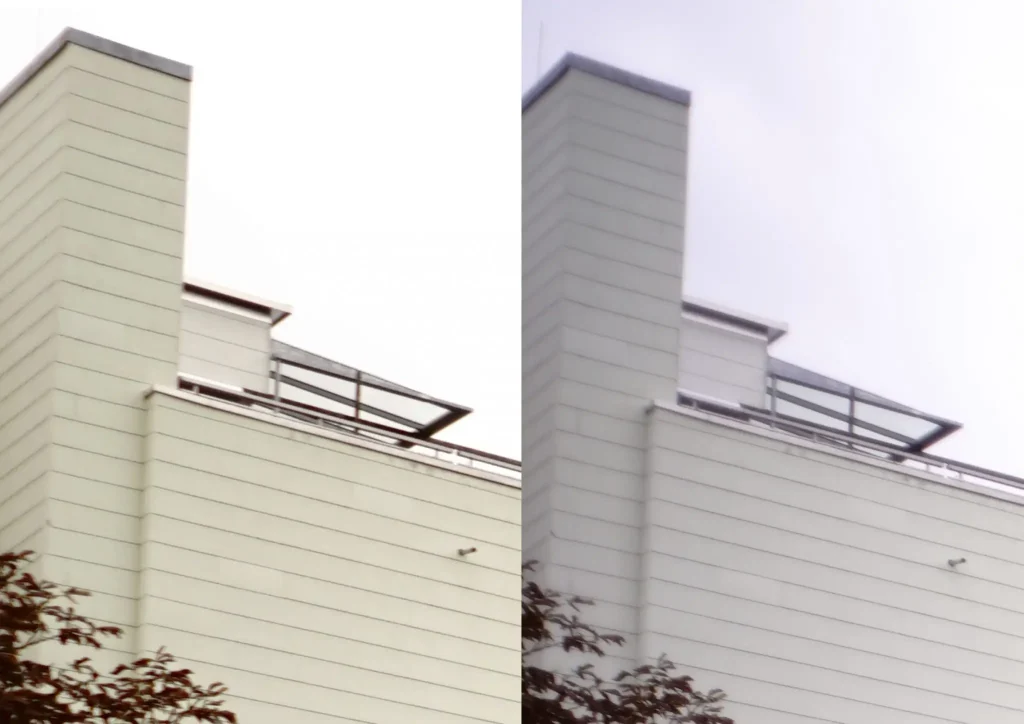
By f5.6 (below) the difference is all but gone, and I have no reservations for using the Minolta M-Rokkor 28mm f/2.8 for landscape from that aperture on. At f/2.8 and f/4 it is pretty sharp in the centre, so it works really well at these apertures too for portraiture and generally indoors, so all apertures are useful!
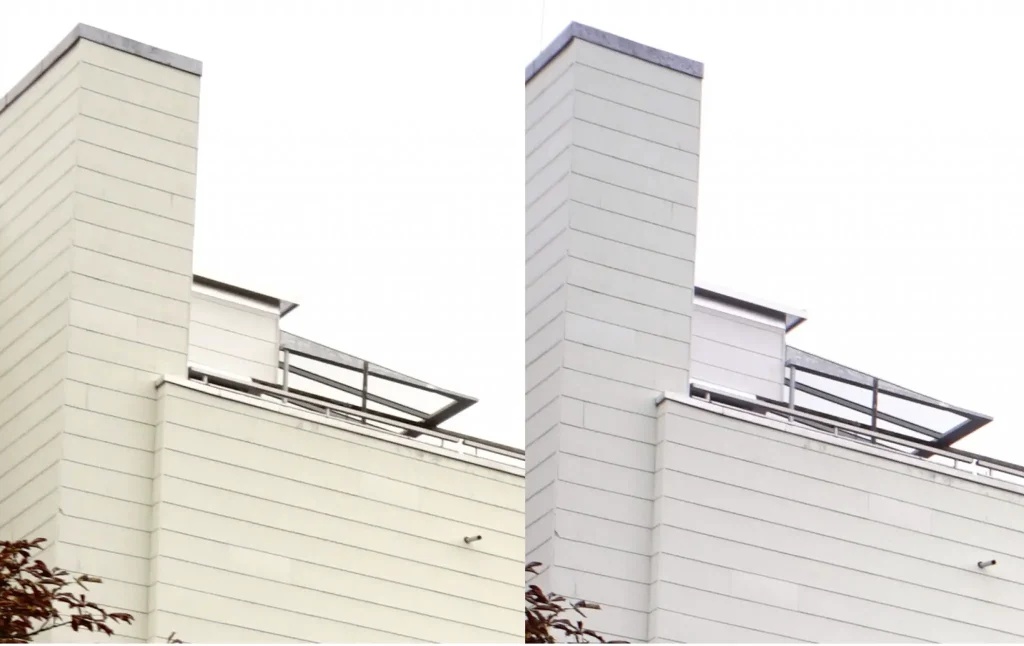
To give you an idea on real-life quality from the Minolta M-Rokkor 28mm f/2.8, here are couple of pictures from A7 (Hamburg and Berlin if you’re interested). All are shot around f/5.6-8 which is how any sane person would shoot them. No complaints on image quality whatsoever. At these apertures the image is tack-sharp throughout the frame, there’s no color cast, no corner smearing, and no big issues with contrast or flare if one watches where the sun is located.
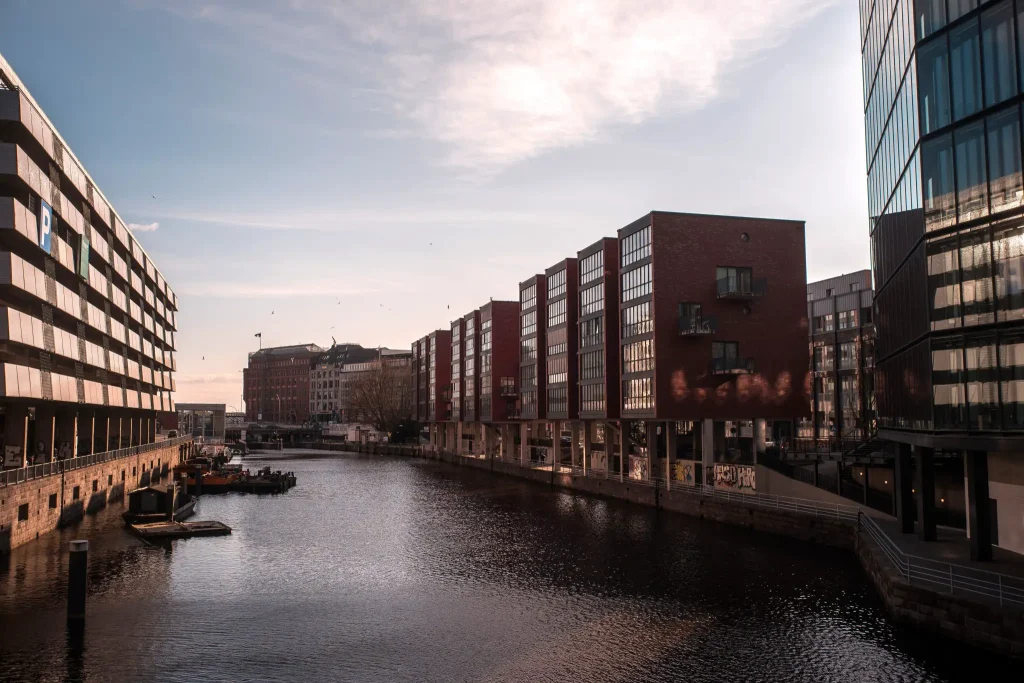
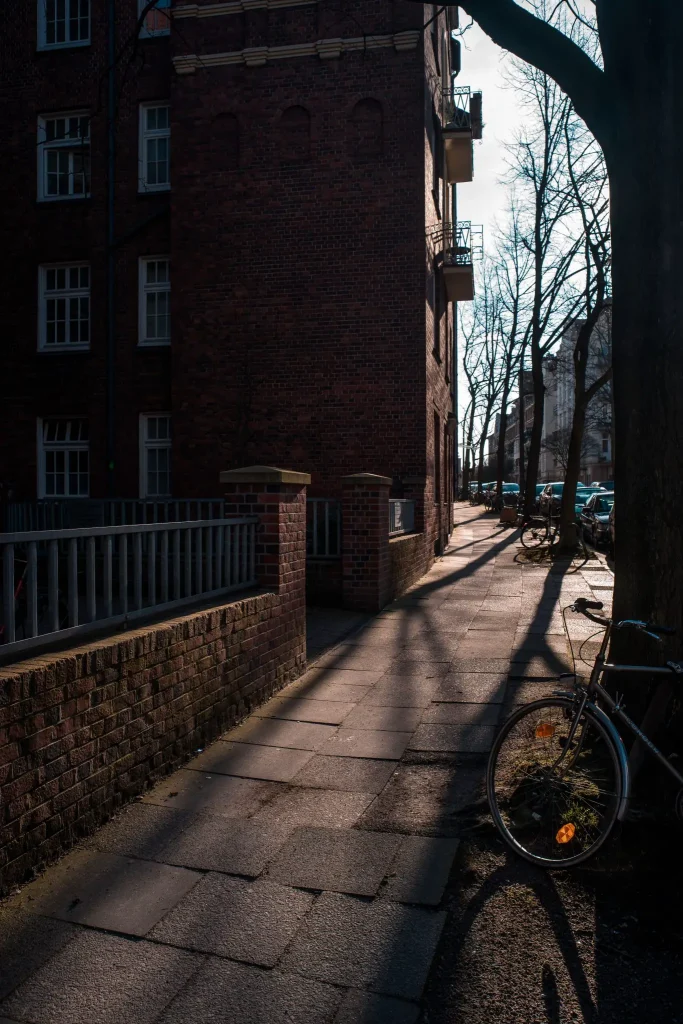
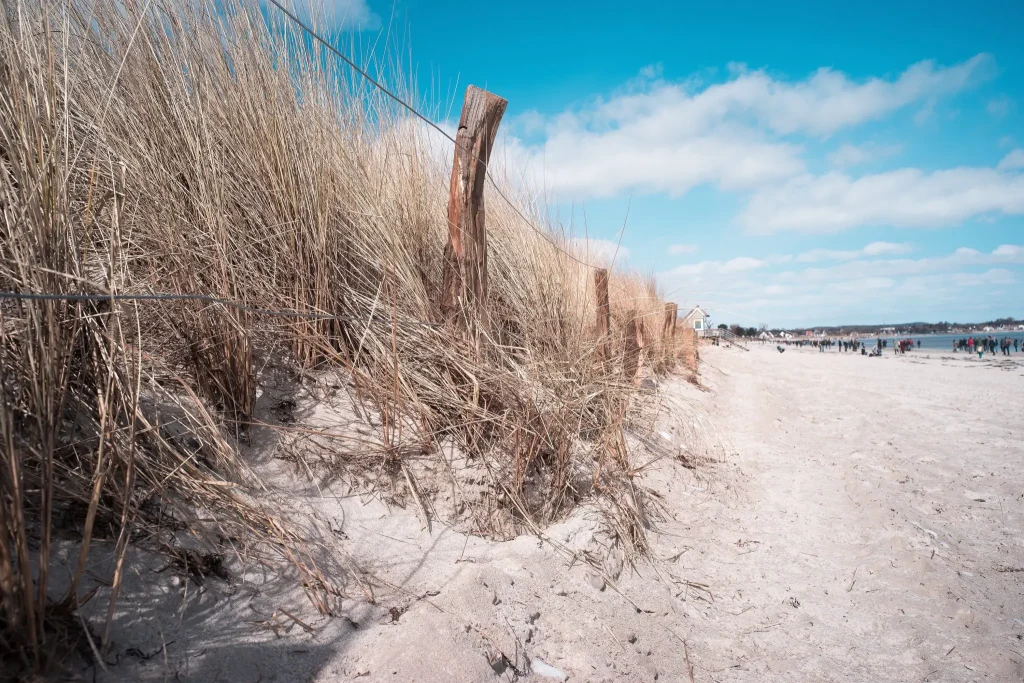

Still, I hesitated to use the lens on film due to the possibility of flare which is easy to control as you shoot on MILC, but not so much when you have no direct feedback. I also have no hood for the lens, so after some further investigation I decided to clean it.
Cleaning
Cleaning the Minolta M-Rokkor 28mm f/2.8 is tricky. My project was inspired by this thread although I modified some steps. The basic idea is that you need to unscrew the front group and saw some metal off the retaining frame holding the group together. After that, one can pull out the front element somehow – that was the most tricky part. I did it by gluing the front element directly to the wooden base with hot glue and then pushing against the metal frame with a lever. Once you get the front element out (carefully!) you can dissolve the hot glue by applying a tiny amount of alcohol between the glass and the glue.
Do not try to polish the “spots out” as some suggested in the forum! Most of what you see as white spots can actually not be polished away.
And actually the white spots per-se are not a problem at all! These are just bubbles of air between the black paint used to blacken the sides of the lens and the glass, are not on the glass surface. They do essentially no harm. Basically, they just make the edges of the lens reflect a bit more light, but mostly to the front, and thus do not reduce contrast! Leave them alone! The real problem are the smaller oily spots on the inside of the front element visible as haze throughout the lens on some copies.
These are, however, just condensation of some substance evaporating from the paint used to blacken the lens sides. If left for ages, they might damage the glass itself, but did not do so on my copy. These spots are easily dissolvable in alcohol, so just let the front element soak in alcohol bath for couple of hours, and then wipe it clean (the inner side). In my case this totally removed the haze and the lens now passes the flash-light test.
Finally, I also did re-coat the sides of the lens with some black marker (paint one, Edding works fine) to get rid of the cosmetic white spots, but that’s not essential. As a result of the cleaning the contrast was substantially improved, and I don’t get any fake “bokeh” balls at small apertures when shooting into the sun anymore.
After the cleaning and re-blackening, my Minolta M-Rokkor 28mm f/2.8 looks almost like new, although there is some coating damage on the front side of my copy. It has nothing to do with the white spots, but perhaps to humidity during storage. The white spots are completely gone 🙂
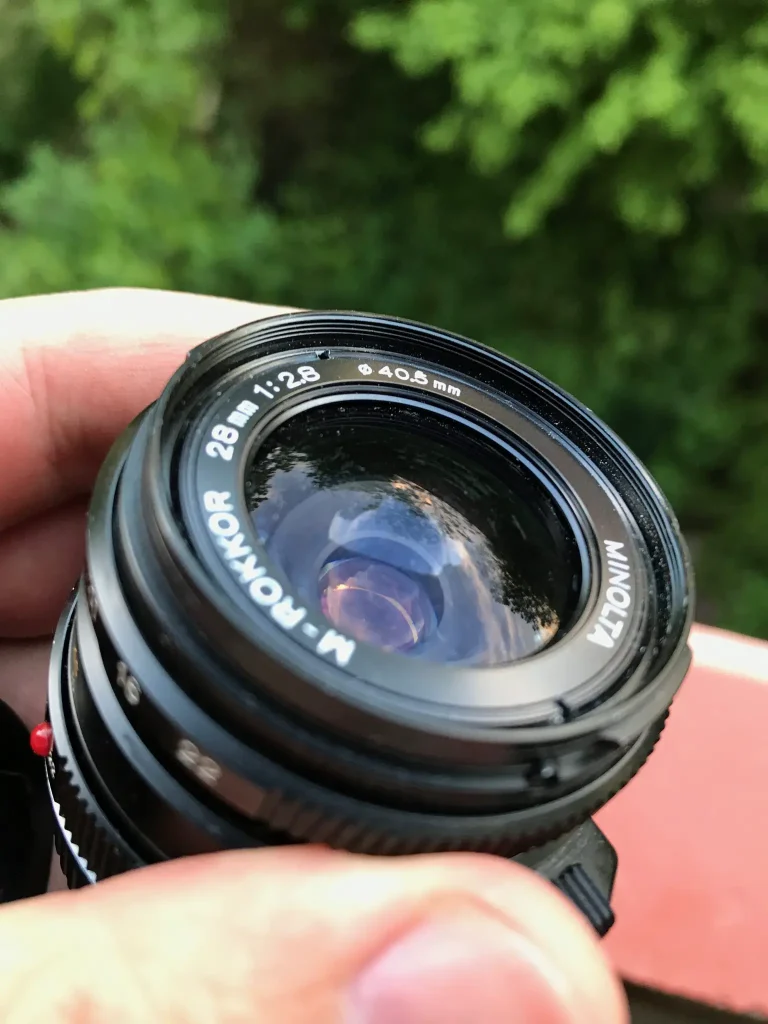
To wrap up, check your lens against the light from the back to front: if you see no “drops”, you don’t need do anything even if the lens from the front looks ugly. If there are some, it may not be as bad as you think, but if you see it is, the problem appears solvable. That’s good news, as the lens is really nice!
Shooting film
As I said, the main reason to replace FE 28 with this Minolta M-Rokkor 28mm f/2.8 was the ability to use the same lens on my Sony A7 and shoot it with film. Film is less demanding, so while I’d say I need at least f/5.6 for good sharpness across the frame on A7, on film even the corners are sharp from f/2.8-4. I’m not great fan of 28mm on black & white, simply because it is hard to compose wide angles nicely with no helpful colour to separate different parts of the picture. Ok, maybe it’s not so hard, and I’m just lame. Anyway, I mostly shoot colour negative film with wide angles, and recently I became big fan of cine stocks.
In particular, I stumbled upon a German firm Silbersalz35 which re-spools Kodak Vision 3 film to 35mm canisters, and does processing and scanning. This is important point as the cine film is not your ordinary colour film and uses a different processing (ECN2). The reason is that the film goes very quickly through camera, so needs an additional “remjet” layer to reduce friction and static electricity. This layer needs to be removed either during or before processing. One solution to the problem is provided by Cinestill, who removes the remjet before re-spooling their films, which can then be processed in C-41 chemistry. That’s not what the cine films are designed for, however, so apparently there may be some differences when you do it this way. Also color correction is not trivial.
On the other hand, Silbersalz35 send you a cine film as it is, with jet black remjet layer, which you then send them back for processing and scanning. All at at ~10 eur per roll including film itself, processing, shipping and high quality scans (21 Mp 16 bit tiffs). They are also close to me (Stuttgart, Germany), so the turnaround is really quick! The film itself is just insanely good, especially ISO50-250! Non-existent grain (at 21 Mp I can’t see any for ISO 50 stock, and barely any at 250), superb latitude and colours, just great! You can also push the film, and I’d go as far as to say that ISO 500 stock pushed to 800 and then edited a bit will outperform my A7 in low light! Silberzalz recommends to over-expose by 1 stop for best results, which I learned only recently, and never did. Keep in mind also that the film is designed for digital post-processing, so by default the image is quite flat. The 16 bit tiffs provided are, however, extremely flexible, so you’re free to edit as you like.
Cleaned Minolta M-Rokkor 28mm f/2.8 on film
Below are some examples from last family trip to Barcelona. This was the first time I tested the cleaned Minolta M-Rokkor 28mm f/2.8, so I tried to “stress-test” it by shooting into the sun. As a result, there’s heavy emphasis on high-contrast situations, often with sun within or just out the frame. All without a hood, just because I don’t have one. All day-time ones are at f/8, the ones in the shadows are wide open as I remember. All were intended to be shot at nominal ISO 250, however, my light meter did some weird stuff, so when I came back I figured out that the pics were actually underexposed by 2 stops.
I found this out upon coming back and developing 2 rolls of HP5 shot using the same meter. Remember that Silbersalz suggests to overexpose by 1 stop, not underexpose by two! Still, the results are nice. The pictures are jpegs as I’ve got them from Silbersalz35, no tweaking beyond resizing and sharpening to the output size to illustrate what you can get directly after scanning. Silberszalz does provide, however, also 16 bit tiffs, so if you’re into editing, you can most likely beat your favourite digital sensor (definitively A7 mark I). There’s no grain whatsoever, and the dynamic range is just insane!
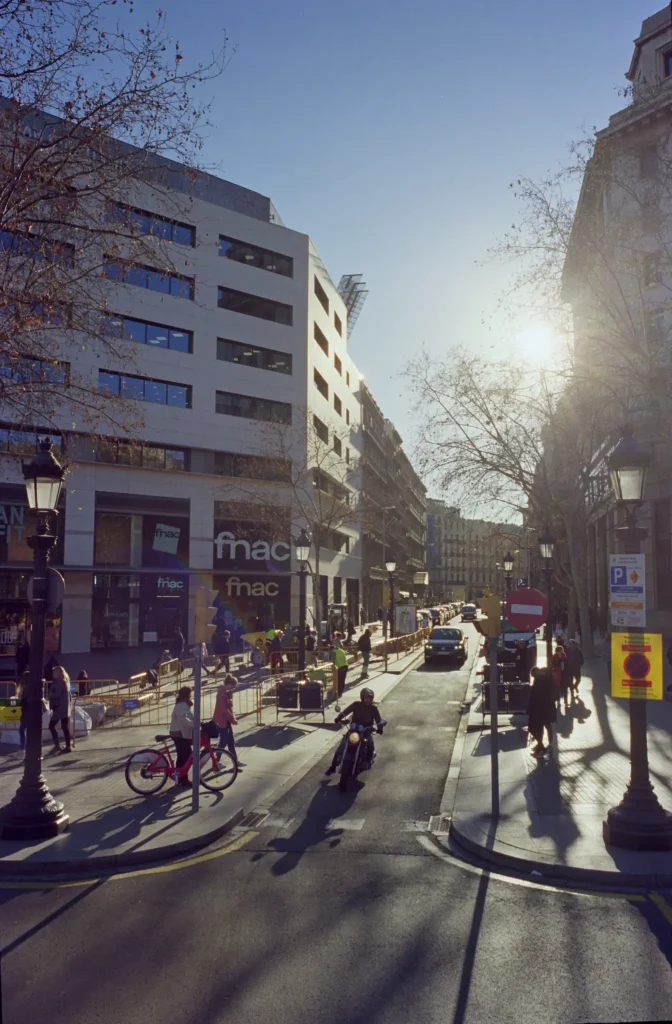
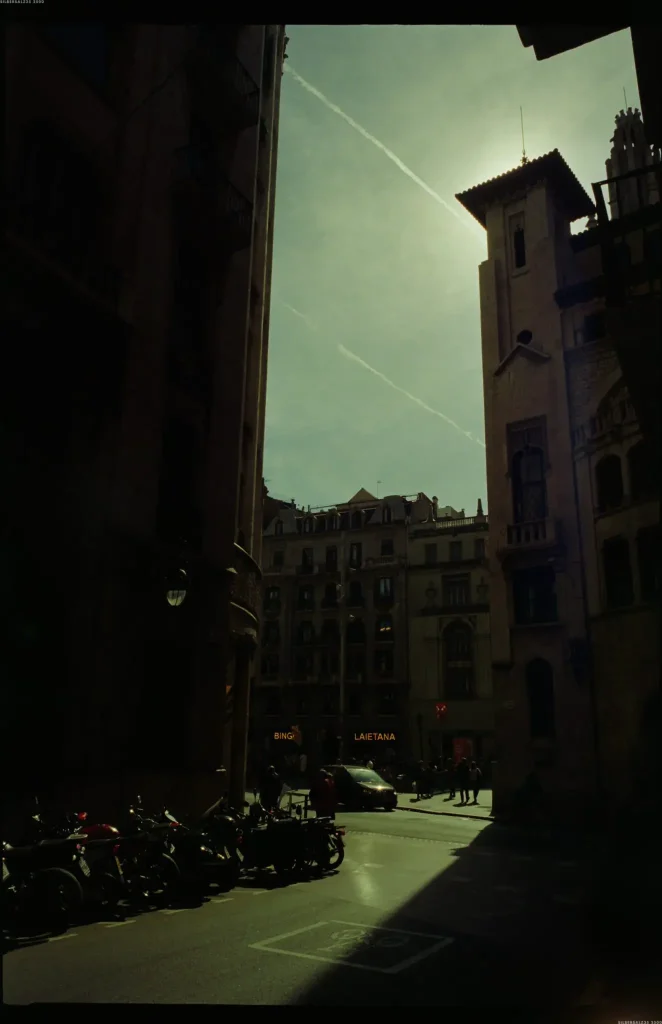
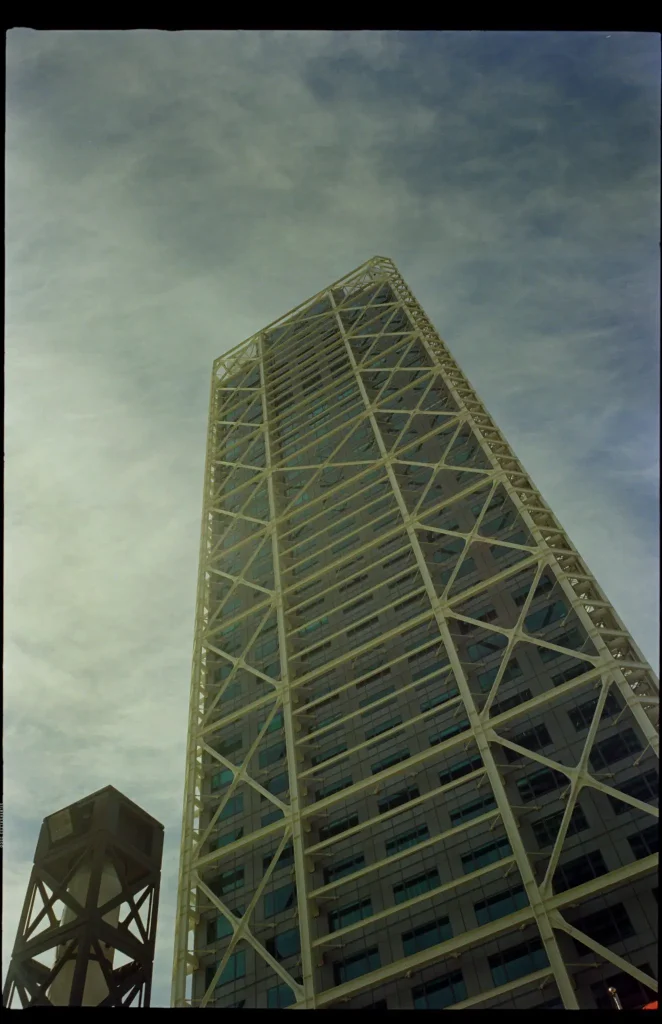
More samples from film
I have also shot multiple rolls since the cleaning the Minolta M-Rokkor 28mm f/2.8, all without a hood, and have yet to encounter serious issues with flare. Here I have included couple of BW shots, which are HP5 processed in HC110.
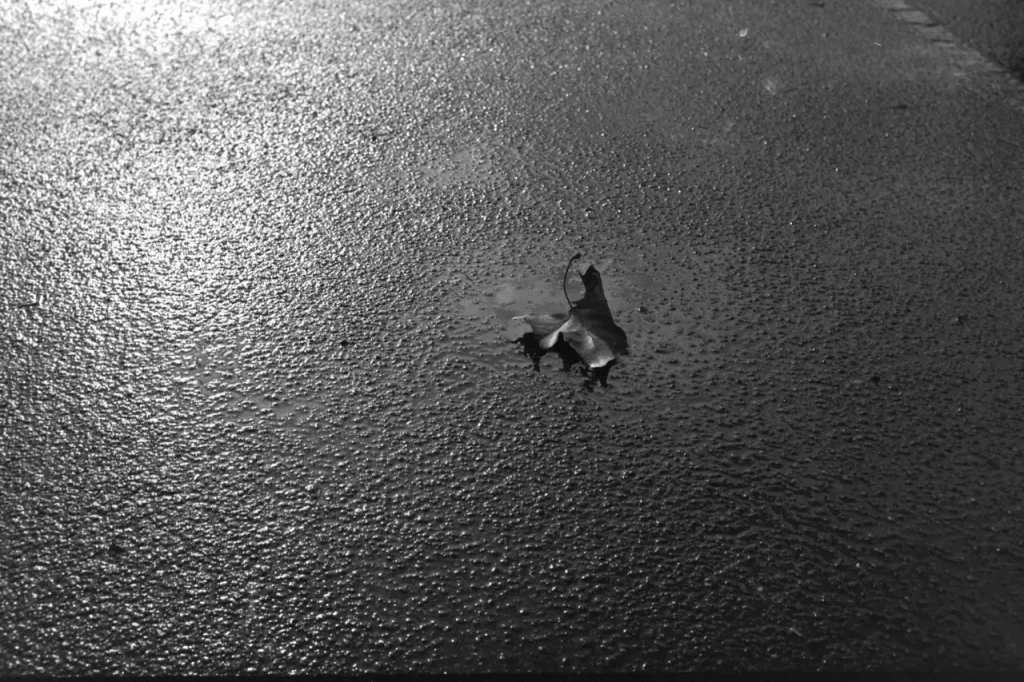
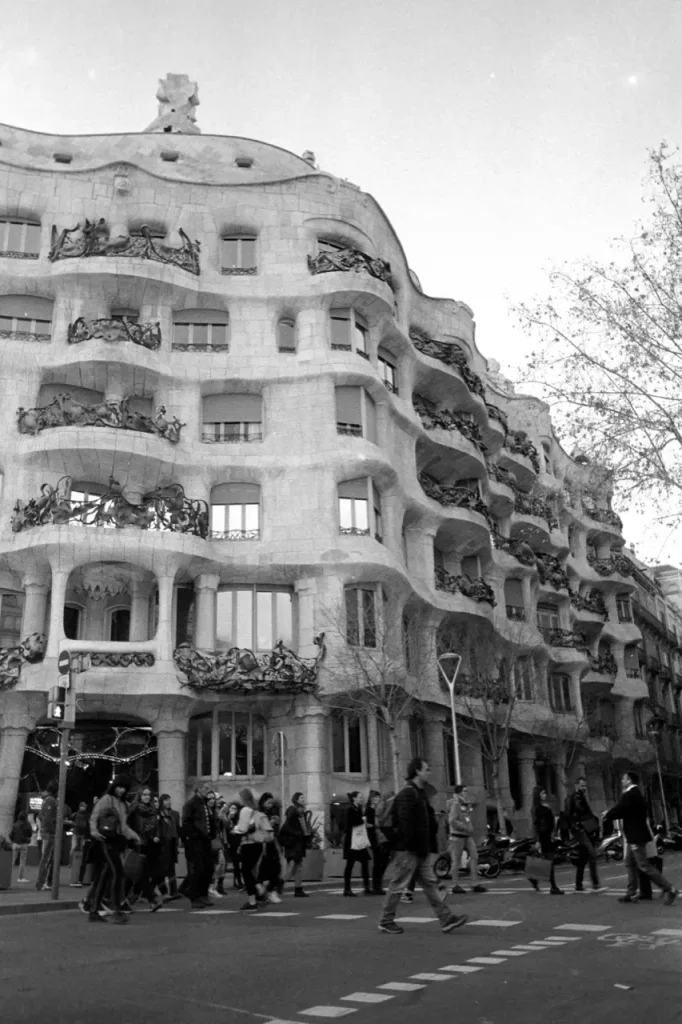
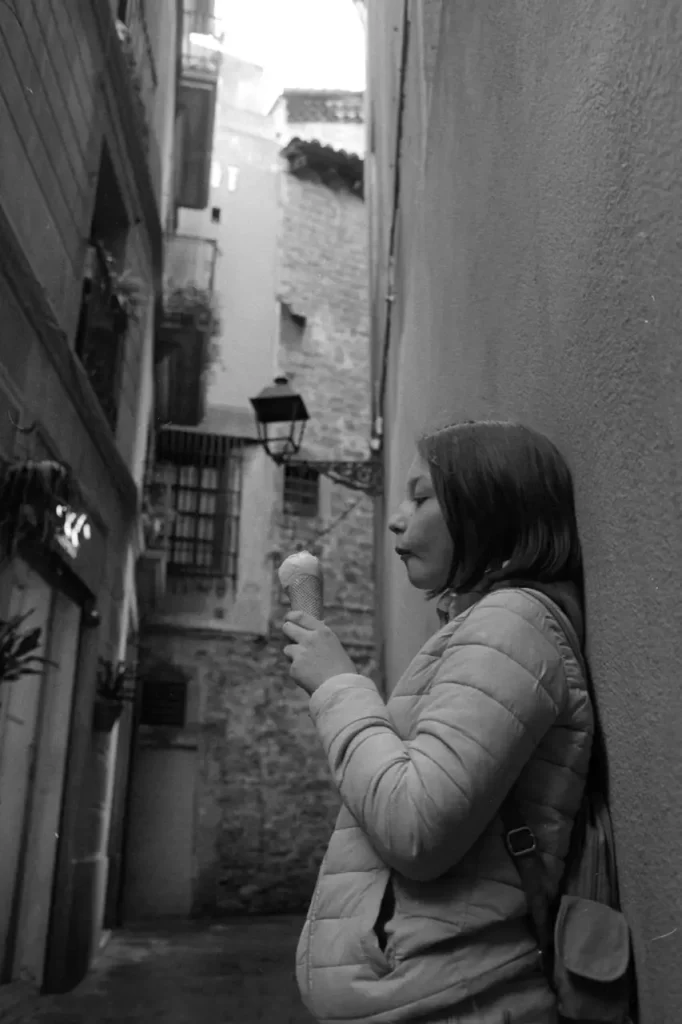
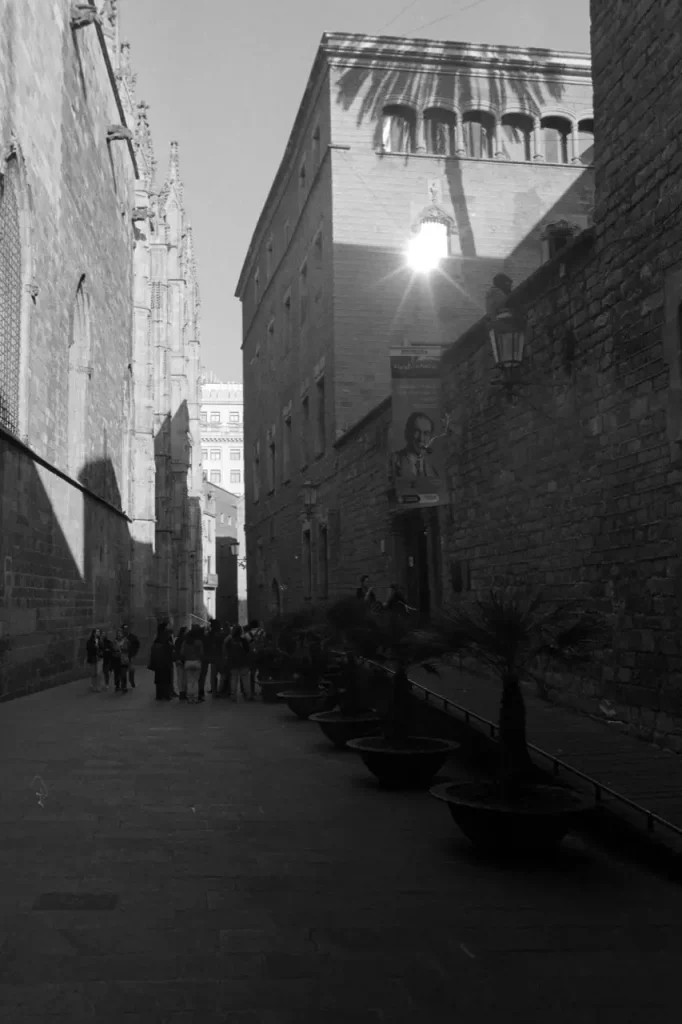
Conclusions
To my knowledge the Minolta M-Rokkor 28mm f/2.8 is the only m-mount lens which performs adequately on A7 series. At 24Mp the resolution is comparable to the FE 28mm at all apertures, with perhaps a bit lower contrast even on a clean copy. The FE is heavier (210 vs 137 g), and bigger, but has autofocus, and f/2 aperture. It is also still is a bit sharper at comparable apertures until ~f/8.
It does not work on M though, which as I’ve said, was the main reason for me to get the Minolta M-Rokkor 28mm f/2.8. On the other hand, I find myself using the later most of the time also on A7, at least when I’m not focusing on fast-paced action like kids. Sharpness-wise I have no reservations using Minolta M-Rokkor 28mm f/2.8 from wide-open for environmental portraiture and from ~5.6 for landscape on 24 Mp. The flare resistance and contrast are also fine both on film and digital, and handling is also good! I tried a 28mm Elmarit, and in comparison was not impressed much by handling and image quality. Because of the white spots, however, you can find a Minolta M-Rokkor 28mm f/2.8 for 1/3 the price, or even less! The white spots are, however, just a minor issue, particularly if there’s no haze as well. Even if there’s, it can be cleaned, so I think overall the lens is one of the biggest bargains for the m-system!
Share this post:
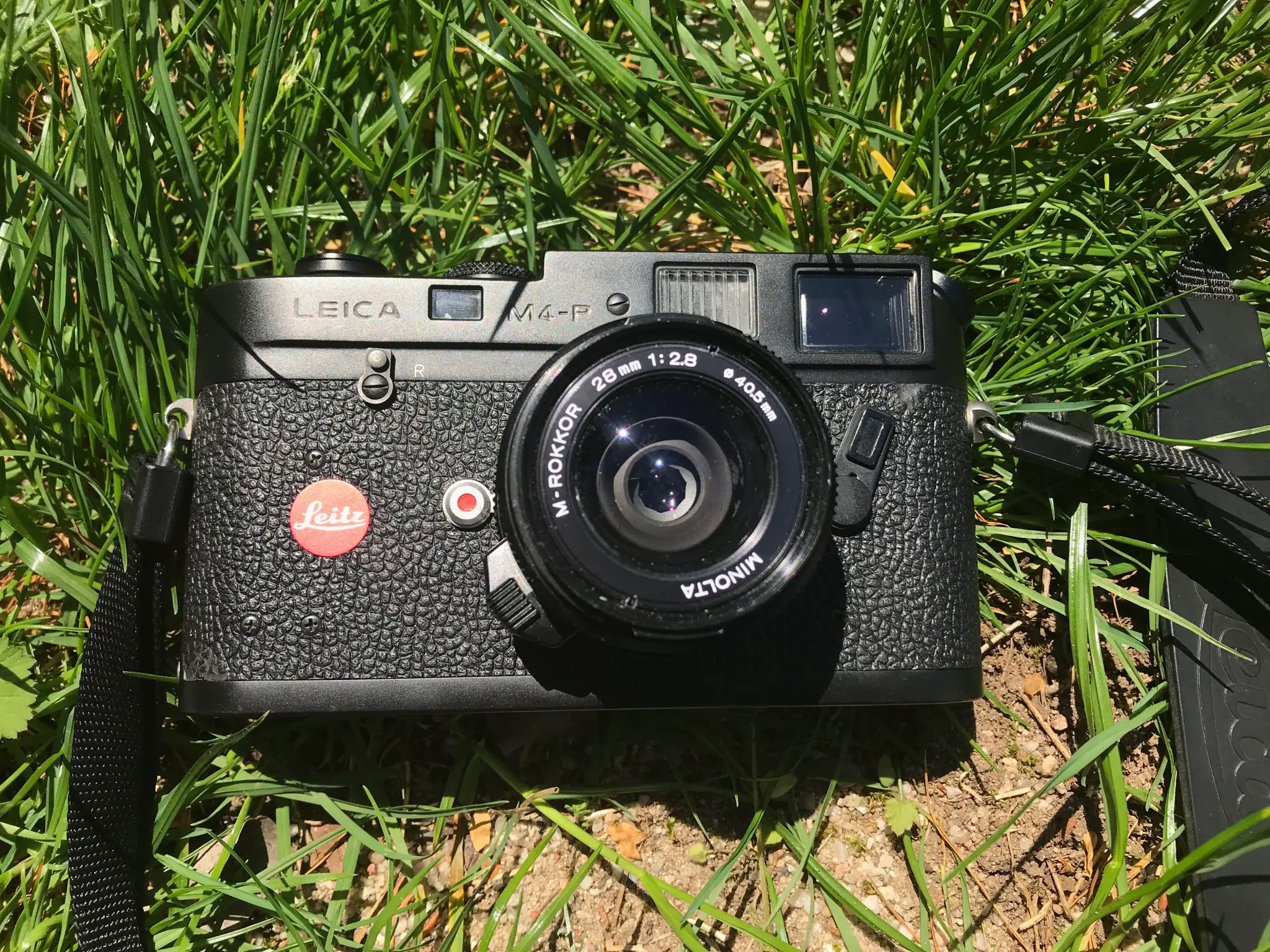








Comments
Krishna Kumar on Minolta 28mm f/2.8 M-Rokkor – Shooting and Repairing – by Victor Doroshenko
Comment posted: 07/06/2019
I have worked with a Minolta AF 28 mm lens and with both AF and MF modes on the more advanced models like the 600 si, the Dynax 7 film cameras ...
I must say that the lens have very good results especially when stopped down to f/5.6 ... The wide angle landscapes as well as the large groups of people images were more than good ... !
Minolta being one of the few excellent camera manufacturers who also were equally good at making their own lenses right from the scratch, always have a special place of honour in the field of photography ...
Comment posted: 07/06/2019
Comment posted: 07/06/2019
Comment posted: 07/06/2019
Bernhard on Minolta 28mm f/2.8 M-Rokkor – Shooting and Repairing – by Victor Doroshenko
Comment posted: 07/06/2019
Comment posted: 07/06/2019
Comment posted: 07/06/2019
Comment posted: 07/06/2019
Jochen Utecht on Minolta 28mm f/2.8 M-Rokkor – Shooting and Repairing – by Victor Doroshenko
Comment posted: 07/06/2019
Keep on shooting!
Comment posted: 07/06/2019
Daniel Castelli on Minolta 28mm f/2.8 M-Rokkor – Shooting and Repairing – by Victor Doroshenko
Comment posted: 07/06/2019
I've had such poor luck working with ANY 28mm lens on my Leica. I've owned one from Leica, Zeiss, Voigtlander. I just can't work with that length. I've used aux. viewfinders, in-camera frame lines (M4-P) and I look at my results and I'm always displeased with my results. This also goes for the 24, 21, et al focal lengths. I'm fine with a 35, 40 (my favorite - 40mm M-Rokkor!) or a 50mm. Everything else, bleh.
It just may be my sense of personal space.
Anyhow, good article & nice pics (girl w/the ice cream.)
Chris Rusbridge on Minolta 28mm f/2.8 M-Rokkor – Shooting and Repairing – by Victor Doroshenko
Comment posted: 08/06/2019
Brian on Minolta 28mm f/2.8 M-Rokkor – Shooting and Repairing – by Victor Doroshenko
Comment posted: 02/07/2022
Comment posted: 02/07/2022